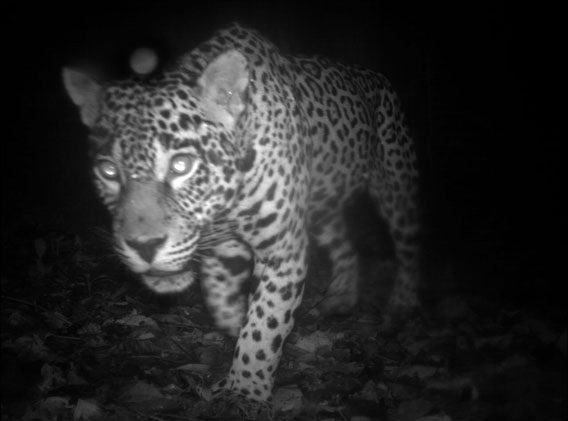
Central Suriname Nature Reserve, Suriname. A jaguar (Panthera Onca), a Near Threatened species. Of the sites researched, Suriname’s site presented the highest number of species diversity. Photo courtesy of Conservation International Suriname, a member of the TEAM network.
A groundbreaking cameratrap study has mapped the abundance, or lack thereof, of tropical mammal populations across seven countries in some of the world’s most important rainforests. Undertaken by The Tropical Ecology Assessment and Monitoring Network (TEAM), the study found that habitat loss was having a critical impact on mammals. The study, which documented 105 mammals (nearly 2 percent of the world’s known mammals) on three continents, also confirmed that mammals fared far better—both in diversity and abundance—in areas with continuous forest versus areas that had been degraded.
“The results of the study are important in that they confirm what we suspected: habitat destruction is slowly but surely killing our planet’s mammal diversity,” said lead author Jorge Ahumada with TEAM and Conservation International (CI) in a press release.
Snapping 52,000 photos in Uganda, Tanzania, Indonesia, Laos, Suriname, Brazil, and Costa Rica, the researchers not only discovered that habitat loss was impacting mammals, but that the size of protected areas mattered: not surprisingly larger protected areas meant richer mammal communities, while smaller protected areas saw mammal diversity drop. According to the paper, the one exception to this finding was National Protected Area. Despite being a large protected area, the mammal community at Nam Kading was the least diverse (13 recorded species) of any of the seven areas sampled. Researchers hypothesize that this is due to over-hunting and poaching in the region along with fragmented habitat. The richest mammals community, in contrast, was recorded in the Central Suriname Nature Reserve (28 mammals recorded). Suriname’s rainforest is largely intact.
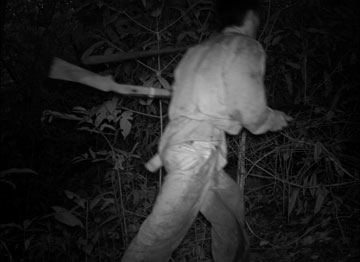 Poacher caught on camera in Nam Kading in Laos. Of the sites researched, this one presented the lowest number of species diversity and the highest habitat fragmentation. Photo courtesy of Wildlife Conservation Society, a member of the TEAM network. |
Researchers also found that habitat loss hit certain types of mammals harder than others.
“Some mammals seem more vulnerable to habitat loss than others: insect-eating mammals—like anteaters, armadillos and some primates, are the first to disappear—while other groups, like herbivores, seem to be less sensitive,” explains Ahumada. The study found that after insectivores, omnivores like bears were next most-affected group by habitat loss.
Tropical mammals provide a number of benefits to the ecosystems they inhabit. Big predators keep a check on herbivores, who otherwise may overgraze with detrimental impacts on plants, while frugivorous (fruit-eating) mammals play a huge role in seed dispersal, which may even impact a forest’s ability to store carbon.
“Some propose that removal of large-bodied tropical terrestrial mammals through intensive hunting can reduce the capacity of tropical
forests to store carbon, either through a reduction in large seeded/high carbon density species mostly dispersed
by frugivorous vertebrates,” the authors write.
Globally, 22 percent of world’s mammals are threatened with extinction according to the IUCN Red List. However, for many of the world’s tropical mammals there is simply not enough data to make a determination on their status. TEAM hopes to help change this.
To gather data that could be readily compared across sites, each site was set up with 60 cameratraps with one cameratrap for every two square kilometers.
“What makes this study scientifically groundbreaking is that we created for the first time consistent, comparable information for mammals on a global scale setting an effective baseline to monitor change. By using this single, standardized methodology in the years to come and comparing the data we receive, we will be able to see trends in mammal communities and take specific, targeted action to save them,” explains Ahumada, “Without a systematic, global approach to monitoring these animals and making sure the data gets to people making decisions, we are only recording their extinctions, not actually saving them.”
The TEAM work is expanding. Since 2010, cameratraps have installed in 10 additional sites: Panama, Ecuador, a second site in Brazil, two sites in Peru, Madagascar, Congo, Cameroon, Malaysia and India. By 2013, plans are to expand the sites to 40.
Areas studied:
Bwindi Impenetrable Forest (Uganda)
Udzungwa Mountains National Park (Tanzania)
Bukit Barisan Selatan National Park (Indonesia)
Nam Kading National Protected Area (Laos)
Central Suriname Nature Reserve (Suriname)
Manaus (Brazil)
Volcan Barva Transect (Costa Rica)
CITATION: Jorge A. Ahumada, Carlos E. F. Silva, Krisna Gajapersad, Chris Hallam, Johanna Hurtado, Emanuel Martin, Alex McWilliam, Badru Mugerwa, Tim O’Brien, Francesco Rovero, Douglas Sheil, Wilson R. Spironello, Nurul Winarni and Sandy J. Andelman.
Community structure and diversity of tropical forest mammals: data from a global camera trap network. Phil. Trans. R. Soc. B 2011 366, 2703-2711. doi: 10.1098/rstb.2011.0115.
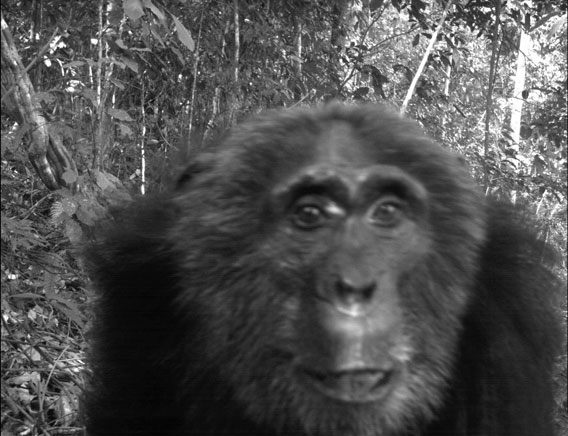
Chimpanzee (Pan troglodytes) an Endangered species from Bwindi impenetrable Forest, Uganda. Photo courtesy of Wildlife Conservation Society, a member of the TEAM network.
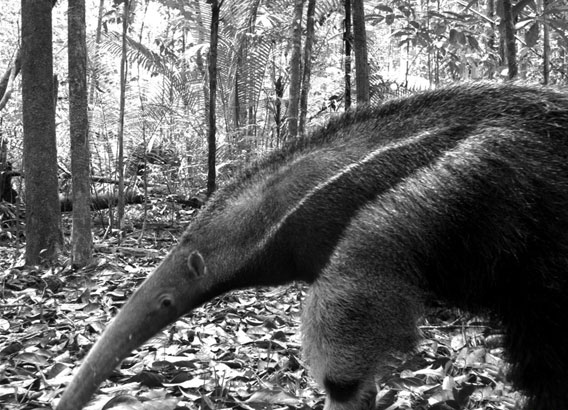
Giant anteater (Myrmecophaga tridactyla) a Vulnerable species in Manaus, Brazil. The study found that habitat loss hurt insectivore populations, such as this anteater, first. Courtesy of Instituto Nacional de Pesquisas da Amazonia, a member of the TEAM network.
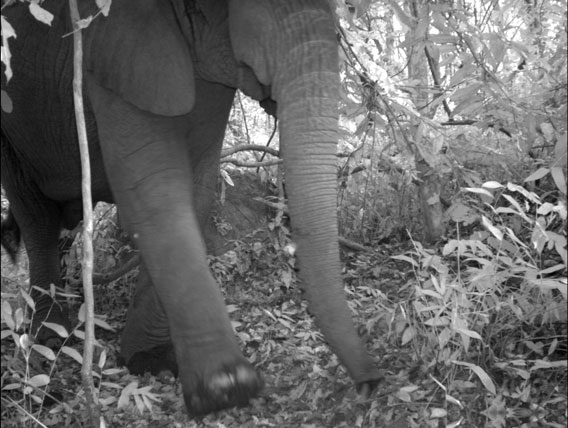
African elephant (Loxodonta africana), a Vulnerable species in the Udzungwa Mountains, Tanzania. This was the largest animal photographed in the study, weighing 8,668 pounds. Courtesy of Museo delle Scienze (Trento Museum of Science), a member of the TEAM network.
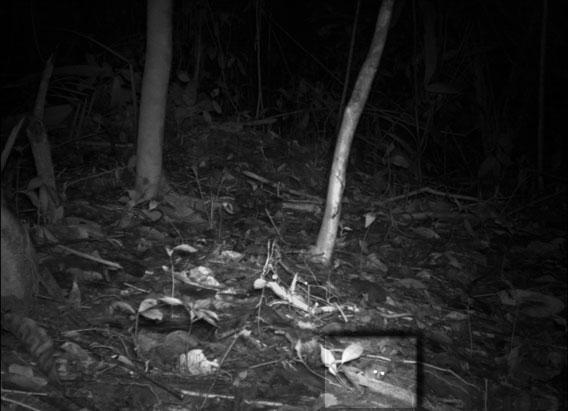
Look hard on the bottom and you’ll see the glowing eyes of the Linnaeus’s mouse opposum (Marmosa murina) in the Central Suriname Nature Reserve. This was the smallest animal photographed in the study. Body length is approximately 4-5 inches with a tail of 5-8 inches. Photo courtesy of Conservation International Suriname, a member of the TEAM network.
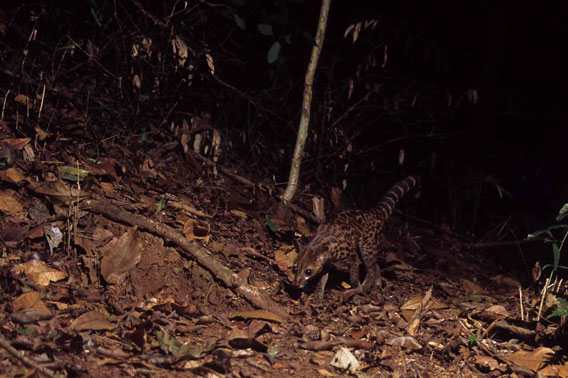
Lowe’s Servaline Genet (Genetta servalina lowei), a small african carnivore in the Udzungwa Mountains, Tanzania. Photo courtesy of Museo delle Scienze (Trento Museum of Science), a member of the TEAM network.
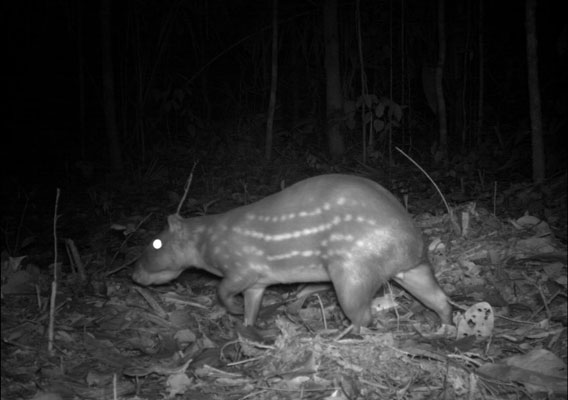
Lowland paca (Cuniculus paca) in Manaus, Brazil. Courtesy of Instituto Nacional de Pesquisas da Amazonia, a member of the TEAM network.
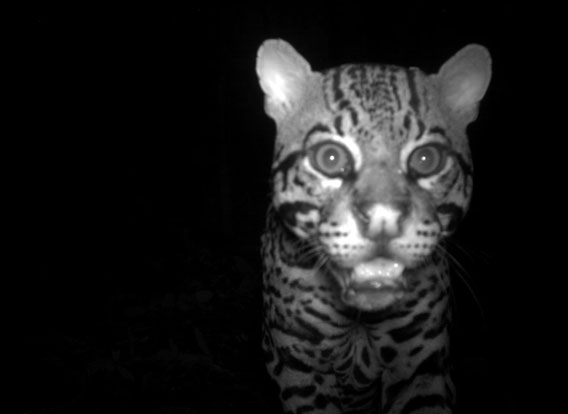
Ocelot (Leopardus pardalis) from Volcan Barva, Costa Rica. Courtesy of Organization for Tropical Studies, a member of the TEAM network.
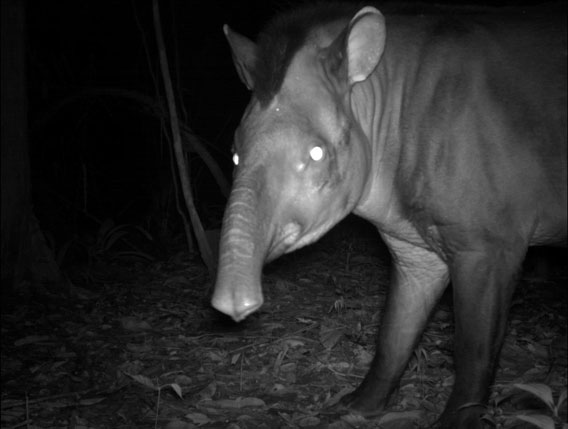
South American Tapir (Tapirus terrestris) a Vulnerable species in Central Suriname Nature Reserve. Courtesy of Conservation International Suriname, a member of the TEAM network.
Related articles
Balancing agriculture and rainforest biodiversity in India’s Western Ghats
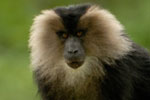
(08/08/2011) When one thinks of the world’s great rainforests the Amazon, Congo, and the tropical forests of Southeast Asia and Indonesia usually come to mind. Rarely does India—home to over a billion people—make an appearance. But along India’s west coast lies one of the world’s great tropical forests and biodiversity hotspots, the Western Ghats. However it’s not just the explosion of life one finds in the Western Ghats that make it notable, it’s also the forest’s long—and ongoing—relationship to humans, lots of humans. Unlike many of the world’s other great rainforests, the Western Ghats has long been a region of agriculture. This is one place in the world where elephants walk through tea fields and tigers migrate across betel nut plantations. While wildlife has survived alongside humans for centuries in the region, continuing development, population growth and intensification of agriculture are putting increased pressure on this always-precarious relationship. In a recent paper in Biological Conservation, four researchers examine how well agricultural landscapes support biodiversity conservation in one of India’s most species-rich landscapes.
Decline in top predators and megafauna ‘humankind’s most pervasive influence on nature’
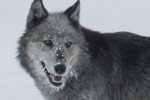
(07/14/2011) Worldwide wolf populations have dropped around 99 percent from historic populations. Lion populations have fallen from 450,000 to 20,000 in 50 years. Three subspecies of tiger went extinct in the 20th Century. Overfishing and finning has cut some shark populations down by 90 percent in just a few decades. Though humpback whales have rebounded since whaling was banned, they are still far from historic numbers. While some humans have mourned such statistics as an aesthetic loss, scientists now say these declines have a far greater impact on humans than just the vanishing of iconic animals. The almost wholesale destruction of top predators—such as sharks, wolves, and big cats—has drastically altered the world’s ecosystems, according to a new review study in Science. Although researchers have long known that the decline of animals at the top of food chain, including big herbivores and omnivores, affects ecosystems through what is known as ‘trophic cascade’, studies over the past few decades are only beginning to reveal the extent to which these animals maintain healthy environments, preserve biodiversity, and improve nature’s productivity.
Camera traps reveal no tigers, but other carnivores in Khao Yai National Park
(06/27/2011) A four-year camera trap project has revealed that Khao Yai National Park in Thailand is still home to a wide-variety of carnivore species, but tigers may be on their way out or already gone finds a new study from mongabay.com’s open access journal Tropical Conservation Science. Photographing with 15 cameras the study snapped photos of 14 carnivore species in the park. However, the photographic evidence implies that predator populations have fallen in the park over the past decade due to human activities, including poaching.